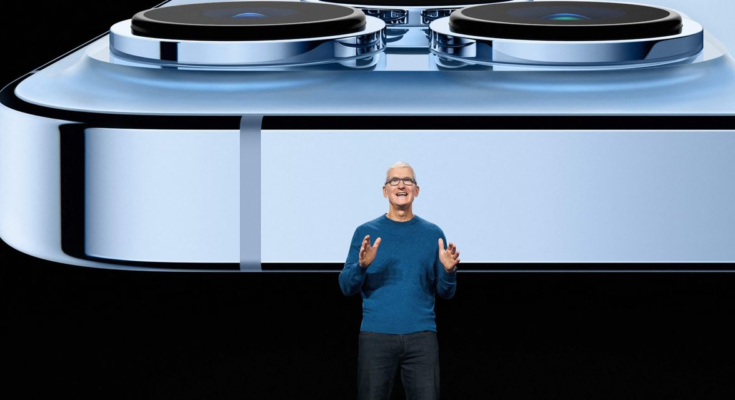Apple Inc.’s latest iPhone event was a snoozefest, but Apple will sell millions of the new smartphones anyway.
Apple
AAPL,
-0.96%
hosted its much anticipated iPhone 13 launch Tuesday, revealing four new models with starting prices that range from $699 for the iPhone 13 Mini to $1,099 for the iPhone 13 Pro Max. The new phones have faster processing, battery longevity improvements, additional storage, camera upgrades and new colors — the same type of slight, iterative improvements that have been introduced for years now, while rumored leaps like satellite communications technology and augmented-reality capabilities were nowhere to be found.
The biggest improvements seemed to be in the built-in cameras of the new iPhones and larger storage capacity — including an offered upgrade of up to a terabyte of data in the iPhone Pro Max — but none of the new offerings came close to the magic Apple regularly produced in the iPhone’s first decade. Yet Apple is still expected to sell millions of the new phones, thanks to a combination of the infrastructure it has in place for its vast ecosystem, a pent-up demand from consumers who have not upgraded in a few years, and an assist from telecom giants.
Apple has introduced plans in the past five years to keep its customers updating their phones, including trade-in programs and subscriptions that allow fans to upgrade to the new iPhone every year while continuing to pay a monthly fee. Apple originally made those moves as subsidies from wireless carriers were being phased out, but now companies such as AT&T Inc.
T,
-0.69%,
Verizon Communications Inc.
VZ,
-0.38%
and T-Mobile US Inc.
TMUS,
-0.85%
are again offering to make deals on iPhones as they compete to push consumers to higher-cost plans that will take advantage of 5G connectivity.
For more: A free iPhone 13? Wireless carriers’ subsidies could make it happen, with some catches
Those who have not yet taken those deals may be finally ready for an upgrade, especially if they have an older phone and their battery struggles to hold a charge and Apple’s updated operating systems bog down older models.
“Apple has a substantial installed base waiting to upgrade,” said Anisha Bhatia, senior technology analyst at GlobalData, in an email. “With massive promotions offering the phones for $0 to $100, the iPhone 13 will continue the 5G supercycle that started with the iPhone 12.”
Event coverage: Apple reveals iPhone 13 lineup, iPad Mini price increase and larger Apple Watch
Dan Ives, a Wedbush Securities analyst, estimated that roughly 250 million iPhone users — out of nearly 1 billion who own Apple’s phones — have not upgraded in more than 3.5 years, calling it a “massive pent-up demand within Apple’s installed base.”
“With roughly 20% of upgrades anticipated out of China, we are continuing to see robust demand in this key region, which bodes well heading into the iPhone 13 upgrade cycle,” Ives said in a note to clients. “We believe the robust consumer product cycle continues globally for Cook & Co.”
Amit Daryanani of Evercore ISI agreed.
“We think the incremental features will make this a compelling product for the 900 million-plus iPhone users who didn’t purchase the iPhone 12, ensuring the iPhone cycle sustains into calendar-year 2022,” he wrote.
More from Therese: Ruling in Epic-Apple case could hit core of App Store, but avoids a dangerous label
Apple appears headed for a rebound in iPhone growth thanks to record holiday sales last year, a needed development as its fastest-growing business faces potentially massive changes amid attention from regulators. The company has reported iPhone sales of more than $153 billion through three quarters of its fiscal year — topping the annual total from each of the two preceding years — and all the new iPhones announced Tuesday are available for preorder and will be available by Sept. 24, putting some sales into the fiscal fourth quarter, ending Sept. 30.
Wall Street analysts expect Apple to approach $194.2 billion in iPhone revenue alone this year, according to FactSet, which would total growth of 55.6% from the year-ago period, making it the first annual increase in iPhone sales in three years. The same is expected in fiscal 2022, which will include holiday sales of the new iPhones, iPads and Apple Watches — Apple is forecast to see $194.5 billion in iPhone revenue for fiscal 2022, according to FactSet.
While Tuesday’s iPhone launch event was seen as incremental at best and boring by many, the thought that Apple needs to come through with a major new technology, such as augmented reality, to excite the world again is missing the point. Apple will sell millions of iPhones without major upgrades, and the cash pile in Cupertino will continue to grow.



